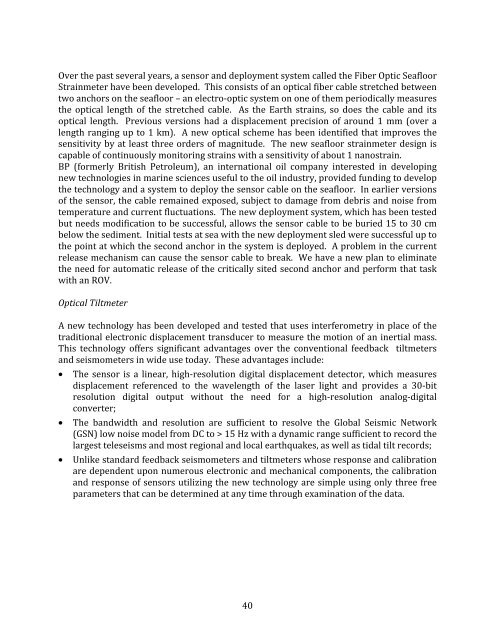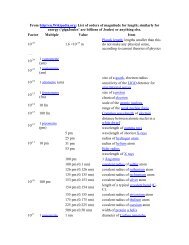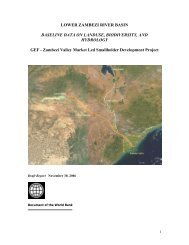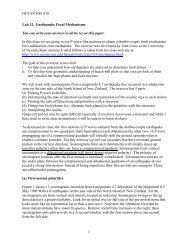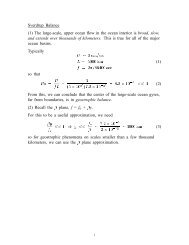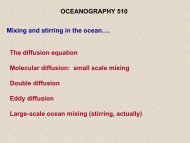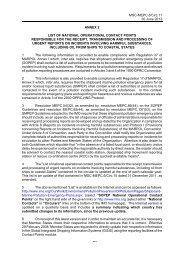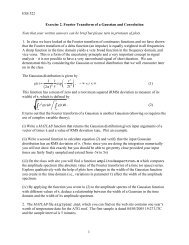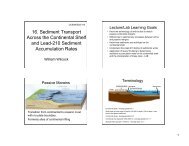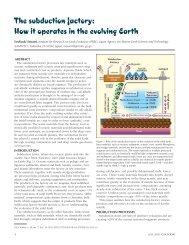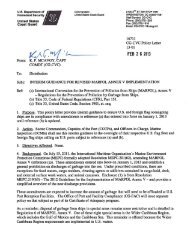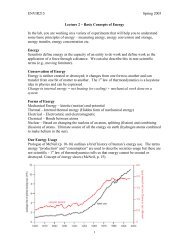2012 Seafloor Geodesy in Cascadia - William Wilcock - University of ...
2012 Seafloor Geodesy in Cascadia - William Wilcock - University of ...
2012 Seafloor Geodesy in Cascadia - William Wilcock - University of ...
You also want an ePaper? Increase the reach of your titles
YUMPU automatically turns print PDFs into web optimized ePapers that Google loves.
Over the past several years, a sensor and deployment system called the Fiber Optic <strong>Seafloor</strong> <br />
Stra<strong>in</strong>meter have been developed. This consists <strong>of</strong> an optical fiber cable stretched between <br />
two anchors on the seafloor – an electro-‐optic system on one <strong>of</strong> them periodically measures <br />
the optical length <strong>of</strong> the stretched cable. As the Earth stra<strong>in</strong>s, so does the cable and its <br />
optical length. Previous versions had a displacement precision <strong>of</strong> around 1 mm (over a <br />
length rang<strong>in</strong>g up to 1 km). A new optical scheme has been identified that improves the <br />
sensitivity by at least three orders <strong>of</strong> magnitude. The new seafloor stra<strong>in</strong>meter design is <br />
capable <strong>of</strong> cont<strong>in</strong>uously monitor<strong>in</strong>g stra<strong>in</strong>s with a sensitivity <strong>of</strong> about 1 nanostra<strong>in</strong>. <br />
BP (formerly British Petroleum), an <strong>in</strong>ternational oil company <strong>in</strong>terested <strong>in</strong> develop<strong>in</strong>g <br />
new technologies <strong>in</strong> mar<strong>in</strong>e sciences useful to the oil <strong>in</strong>dustry, provided fund<strong>in</strong>g to develop <br />
the technology and a system to deploy the sensor cable on the seafloor. In earlier versions <br />
<strong>of</strong> the sensor, the cable rema<strong>in</strong>ed exposed, subject to damage from debris and noise from <br />
temperature and current fluctuations. The new deployment system, which has been tested <br />
but needs modification to be successful, allows the sensor cable to be buried 15 to 30 cm <br />
below the sediment. Initial tests at sea with the new deployment sled were successful up to <br />
the po<strong>in</strong>t at which the second anchor <strong>in</strong> the system is deployed. A problem <strong>in</strong> the current <br />
release mechanism can cause the sensor cable to break. We have a new plan to elim<strong>in</strong>ate <br />
the need for automatic release <strong>of</strong> the critically sited second anchor and perform that task <br />
with an ROV. <br />
Optical Tiltmeter <br />
A new technology has been developed and tested that uses <strong>in</strong>terferometry <strong>in</strong> place <strong>of</strong> the <br />
traditional electronic displacement transducer to measure the motion <strong>of</strong> an <strong>in</strong>ertial mass. <br />
This technology <strong>of</strong>fers significant advantages over the conventional feedback tiltmeters <br />
and seismometers <strong>in</strong> wide use today. These advantages <strong>in</strong>clude: <br />
• The sensor is a l<strong>in</strong>ear, high-‐resolution digital displacement detector, which measures <br />
displacement referenced to the wavelength <strong>of</strong> the laser light and provides a 30-‐bit <br />
resolution digital output without the need for a high-‐resolution analog-‐digital <br />
converter; <br />
• The bandwidth and resolution are sufficient to resolve the Global Seismic Network <br />
(GSN) low noise model from DC to > 15 Hz with a dynamic range sufficient to record the <br />
largest teleseisms and most regional and local earthquakes, as well as tidal tilt records; <br />
• Unlike standard feedback seismometers and tiltmeters whose response and calibration <br />
are dependent upon numerous electronic and mechanical components, the calibration <br />
and response <strong>of</strong> sensors utiliz<strong>in</strong>g the new technology are simple us<strong>in</strong>g only three free <br />
parameters that can be determ<strong>in</strong>ed at any time through exam<strong>in</strong>ation <strong>of</strong> the data. <br />
40


